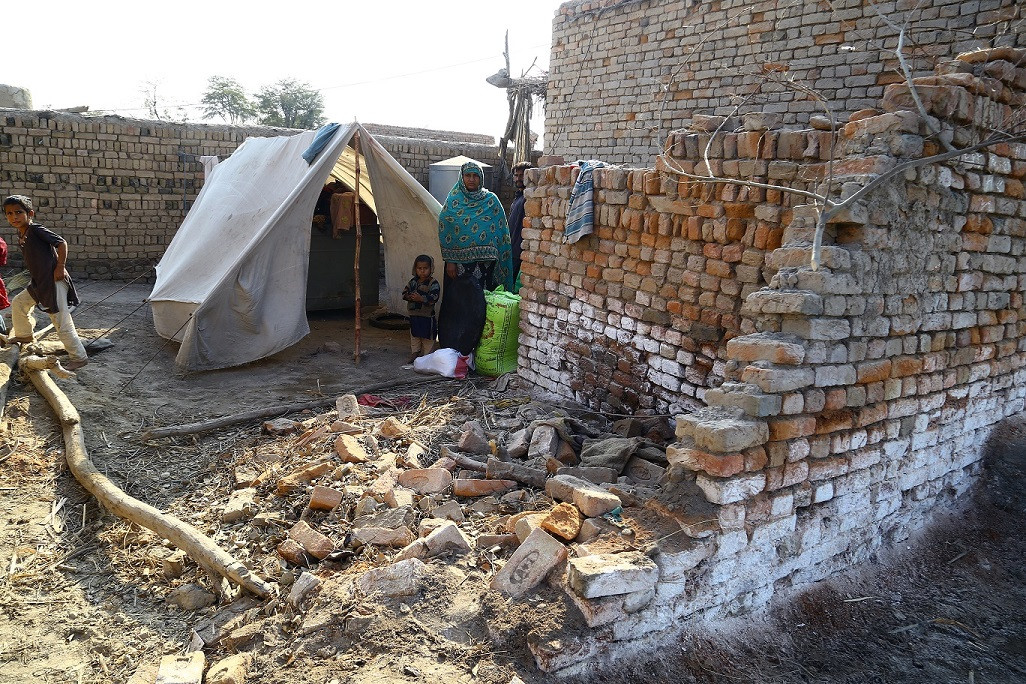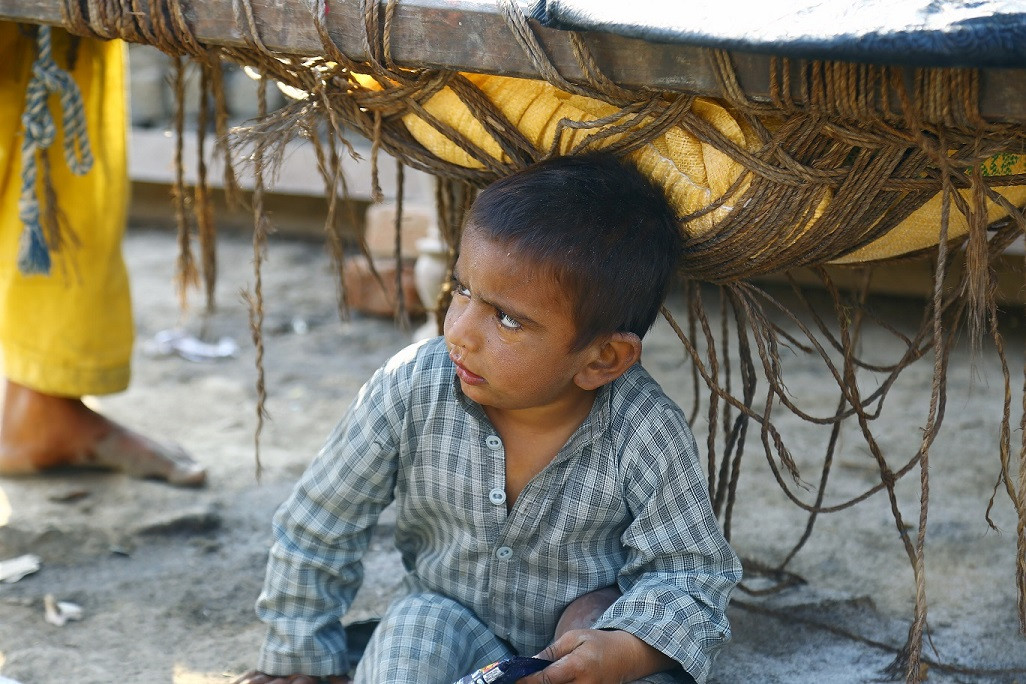“I don’t have brothers and my father is ill and can’t work so I have to work to put bread on the table for my family of four,” says Rizwana, a minor girl, selling chickpeas in a village named Dhodha, near Kandiaro, a town in Naushahro Feroze district, situated some 150 km from Sukkur. The little chickpea seller is clad in clean clothes, and covers her head with a net duppatta. “Many children in this village and the surrounding villages have to hawk goods to support their families,” she tells me, “especially after the torrential rain and flood [of August 2022].”
After she has sold all the chickpeas, I accompany her to her home. On the way, I see another little girl selling oranges, while a little boy is selling sweet potatoes. Rizwana’s home was destroyed in the torrential rains. We find her ailing father sleeping on a broken cot under the open skies. Her mother, Hurmat, sat near the fireplace, is trying to start a fire probably to cook a meal. Hurmat says that before August, things were going smoothly. Her husband used to earn 500 to 700 rupees a day, “Which was good for our family,” she says, “but, after the rain, he fell ill and is still unable to go to work.” Even if he wasn’t ill, she adds, he wouldn’t be able to find work as all the agricultural land is inundated.

Rizwana has proved a good support to the family in these testing times, says her mother. “She doesn’t earn much, but whatever she does is enough for a single meal,” Hurmat says, as she blows into the stove through a pipe to light it. Her husband, Ghulam Ali, rouses from his slumber and asks who she is talking to. A journalist from Sukkur is visiting our village, she answers. Ghulam Ali tries to sit upright but failing asks me to come close to him.
“The rains were a curse for us,” he tells me. “Everyone seems to be suffering, without any discrimination between the rich and poor.” Ghulam Ali lost his work because all the farmland was submerged in the flood. “We are literally cut off from the nearby towns and cities,” he adds. “I am bed-ridden due to illness and my little daughter has taken over the reins of the family.”
This was the story of one house in the badly affected village. Similar and even worse scenes were observed in other houses. The destruction is heart-wrenching, as the majority of dwellings have washed away and people are forced to live under the open skies.
I meet a nine-year-old boy, Murad, who is selling small fish for as low as 30 rupees a piece. Today he has sold 15 fish and is happily showing off his earnings. “I will buy some grocery for my family because we haven’t had a meal for the last two days,” Murad says. They have been surviving on rusks and a little bit of tea.

Though the residents of rural Sindh have long been in the clutches of poverty, living without basic facilities, they were sort of content with whatever little they earned to feed their families. Most of the local men and women worked on the agricultural lands owned by landlords, from which they got some share of every yield along with a bit of wages. Others worked as labourers in the nearby towns and cities. Since the flashflood of August 2022, which lashed the entire country, and particularly Sindh, the landowners have been unable to sow crops and the standing water has caused extensive damage to the infrastructure, especially the kutcha and pukka houses. A local landlord Basharat Sahto, who sustained huge losses, tells Tribune Magazine that all the crops on his lands were damaged. The field is still swamped with water.
Sahto had sown cotton and sugarcane on 40 acres of land, all of which was completely damaged due to the torrential rains. “Not only this, but the stagnant water on our agriculture lands is playing further havoc,” he says, “as we will not be able to cultivate it for a year or so.” Even after the water is drained out, it will take hard labour and money to make it ready for cultivation again.

Thousands of villages are still cut off from the towns and cities and their residents, homeless, live a miserable existence. The only ray of hope for them is the distribution of dry ration and other items along with free medical camps established by non-governmental organizations such as the Sukkur-based Riverside Development Organisation (RDO). Funded by the Community Organised Relief Efforts, RDO is trying its best to reach out to the marooned population and mitigate their sufferings to some extent.
I visited some flood-affected villages in the Kandiaro taluka with the RDO team. In Dhodha, Bilbar Budh and Attur Budh, people came out from nowhere and surrounded the RDO truck carrying the dry ration and other relief goods. Sahto provided us space for storing the ration bags for distribution. Men and women thronged the place in an attempt to procure ration for their families. The dry ration, along with hygiene kits and mosquito nets, was distributed among the people who had registered themselves a day before the distribution. Apart from this, blankets, pillows, tents, tarpaulin sheets, animal nets and mats were also distributed.
An elderly widow, Mai Bebul, is one of the recipients of RDO’s relief goods and ration. Her husband died a couple of years ago, leaving behind five sons and four daughters. Four of her sons are married and lived in separate houses, while the daughter and the youngest son live with her. Before the flood, her son earned 500 to 600 rupees per day, but now he mostly returns home empty-handed. “We are not able to eat even a single meal,” Mai Bebul says, wearing a painful smile on her wrinkled face. “This is the second ration I am getting in the last six months. The first time, the local landlord had distributed ration among the poor, but how long can a single person help the people?” she says.

Maryam, a young widow, has two daughters and three sons but no means of income for her family. However she catches fish from the stagnant water. Due to the heavy rainfall, some of the fish farms in the area have ceased to exist and the fish have gone astray and swim in the stagnant water. “Sometimes I catch more fish, which I sell and thus buy some grocery with the earnings,” Maryam says.
Old Mai Subhana is joyous upon receiving ration, which contains 40 kgs of wheat flour, five kgs of rice, three kgs sugar, pulses, chickpeas, beans, salt, spices, cooking oil, soaps, lotions, tea, washing powder and much more. According to her, this ration is sufficient for her family of seven for a whole month.
Munawwar Gill, the founding chairman of RDO, who is personally supervising the relief work, says, “With the funding of donors, we are doing whatever we can, but so much more is needed.” Talking about the future plan, he shares that the NGO is planning to construct a metalled road from Kandiaro to these villages in order to give them easy access to the city. Seven months after the catastrophe paralysed life in Sindh, the flood affectees await help to not only uplift their living conditions but, indeed, to survive.
Sarfaraz Memon is a freelance journalist and contributor based in Sukkur. All facts and information are the responsibility of the writer
